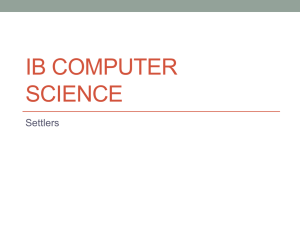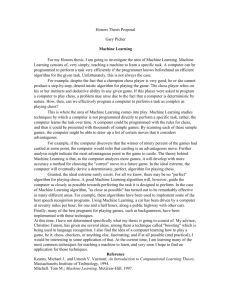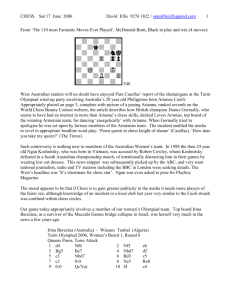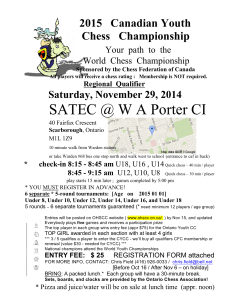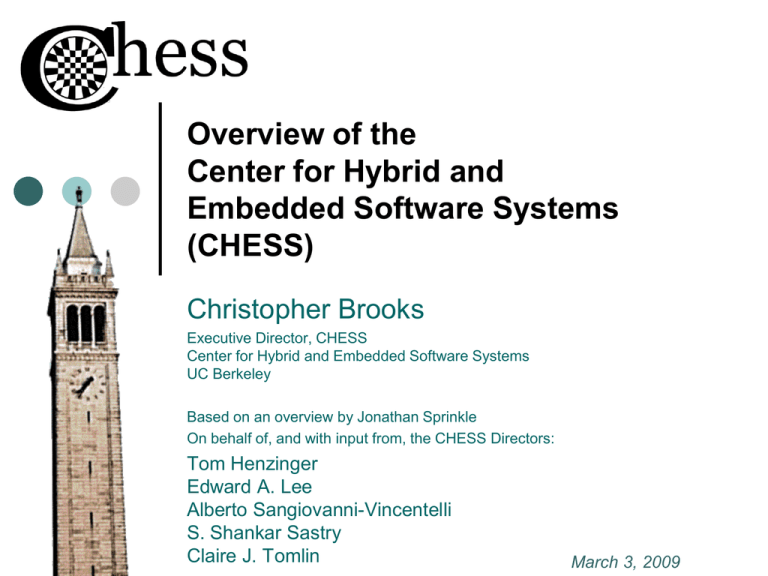
Overview of the
Center for Hybrid and
Embedded Software Systems
(CHESS)
Christopher Brooks
Executive Director, CHESS
Center for Hybrid and Embedded Software Systems
UC Berkeley
Based on an overview by Jonathan Sprinkle
On behalf of, and with input from, the CHESS Directors:
Tom Henzinger
Edward A. Lee
Alberto Sangiovanni-Vincentelli
S. Shankar Sastry
Claire J. Tomlin
March 3, 2009
2001 National Research Council Report
Embedded Everywhere
“Information technology (IT) is on the verge of another revolution. Driven by
the increasing capabilities and ever declining costs of computing and
communications devices, IT is being embedded into a growing range of
physical devices linked together through networks and will become ever
more pervasive as the component technologies become smaller, faster,
and cheaper... These networked systems of embedded computers ... have
the potential to change radically the way people interact with their
environment by linking together a range of devices and sensors that will
allow information to be collected, shared, and processed in unprecedented
ways. ... The use of [these embedded computers] throughout society could
well dwarf previous milestones in the information revolution.”
March 3, 2009
Christopher Brooks, "CHESS Overview"
2
Background on Chess
Founded in 2002
5 year National Science Foundation Funding with Partners:
University of California, Berkeley
Vanderbilt (ISIS)
University of Memphis
Past Interactions with:
DGIST
General Motors
Hewlett-Packard
HSBC Bank
Infineon
Current Government Sponsors
Microsoft
National Science Foundation
Current Industry Partners and Affiliates:
(NSF)
Agilent
Air Force Research Lab (AFRL)
Bosch RTC
U.S. Air Force Office of Scientific
Lockheed-Martin
Research (AFOSR)
National Instruments
U.S. Army Research Office
Toyota
(ARO)
March 3, 2009
Christopher Brooks, "CHESS Overview"
3
Chess Leadership
Board of Directors
Tom Henzinger
Edward A. Lee
Alberto Sangiovanni-Vincentelli
S. Shankar Sastry
Claire J. Tomlin
Executive Director
Christopher Brooks
Other key faculty at Berkeley
Dave Auslander
Ahmad Bahai
Ruzena Bajcsy
Ras Bodik
Karl Hedrick
Kurt Keutzer
George Necula
Koushik Sen
Sanjit Seshia
Masayoshi Tomizuka
Pravin Varaiya
March 3, 2009
Christopher Brooks, "CHESS Overview"
This carefully constructed
team blends domain
experts (for example, in
automotive systems,
avionics, signal and image
processing, and
communications) with
software technologists and
computer scientists.
4
Cyber-Physical Systems
"A cyber-physical system (CPS) integrates computing
and communication capabilities with monitoring and / or
control of entities in the physical world dependably,
safely, securely, efficiently and in real-time.“
- S. Shankar Sastry
March 3, 2009
Christopher Brooks, "CHESS Overview"
5
Cyber-Physical Systems (CPS) Activity
NSF Workshop on CPS: Oct. 16 – 17, 2006, Austin
CPS as part of RTSS: Dec. 3-6, 2007, Tucson
CPS Week: April 21-24, 2008: St Louis (sponsored by CHESS)
Architecture and Composibility for Cyber-Physical
Systems
Part of RTAS, IPSN and HSCC
and other CPS workshops . . .
March 3, 2009
Christopher Brooks, "CHESS Overview"
6
Upcoming CPS Events
•
•
•
CPS Week, San Francisco, April 13-16, 2009: 3 Conferences
(RTAS/ISPN/HSCC)
• a CPS Poster session on Monday evening, April 13
• a CPS panel on Wednesday, April 15
NSF Proposal, due on February 27, 2009: $30 million over 5 years
• Three CPS Themes:
• Foundations
• Methods and Tools
• Components, Run-time Substrates, and Systems
• Funding three sizes of projects:
• Small (individual or small-team efforts) - $200k/year for up to 3 years
• Medium (one or PIs) - $500k/year for up to 3 year
• Large (multiple PI’s) - $1million/year for up to 5 years
Special issue of IEEE Transactions on Parallel and Distributed Systems (~May,
2009)
March 3, 2009
Christopher Brooks, "CHESS Overview"
7
Mission of Chess
To provide an environment for graduate research in
cyber-physical systems by developing
Model-based design
Tool-supported methodologies
For
Real-time
Fault-tolerant
Robust
Secure
Heterogeneous
Distributed
Software
March 3, 2009
We are on the line
to create a “new
systems science”
that is at once
computational and
physical.
The fate of
computers
lacking
interaction with
physical
processes.
Christopher Brooks, "CHESS Overview"
8
Some Applications Addressed
Avionics: UAVs
Automotive
Automotive
Systems Biology
Networked
Embedded Systems
March 3, 2009
Christopher Brooks, "CHESS Overview"
9
Project Approach
Model-Based Design (the view from above)
Platform-Based Design (the view from below)
principled frameworks for design
specification, modeling, and design
manipulable (mathematical) models
enabling analysis and verification
enabling effective synthesis of implementations
exposing key resource limitations
hiding inessential implementation details
Tools
concrete realizations of design methods
March 3, 2009
Christopher Brooks, "CHESS Overview"
10
Claire J. Tomlin:
Decentralized Control of a Quadrotor
Aircraft Fleet to seek Information
Students: Jeremy Gillula, Haomiao Huang Vijay Pradeep,
Robin Raffard, Javad Rezvani Jalal, Kaushik Roy Michael
Vitus, Steve Waslander
Planning operations for teams of aircraft
Collision Avoidance, Region Surveillance
Stanford Testbed of Autonomous
Rotocraft for Multi-Agent Control
(STARMAC)
MURI with Vanderbilt, CMU,
Stanford and Berkeley
March 3, 2009
Christopher Brooks, "CHESS Overview"
11
Alberto Sangiovanni-Vincentelli:
COmmunication Synthesis
Infrastructure (COSI)
Other Researchers: Alessandro Pinto (UTRC),
Luca Carloni (Columbia Univ.)
A public-domain design framework for
the design exploration and synthesis
of interconnection networks. .
Based on the Platform-Based Design paradigm
On chip communication
design flow
Result: optimization
interconnection network
Core
March 3, 2009
Router
Sensors
Actuators
Hypothetical HVAC Design
Result: wired and wireless
networks
Christopher Brooks, "CHESS Overview"
12
S. Shankar Sastry:
Control of Hybrid Systems
“Embedded and autonomous software, computer vision, and
computation in novel substrates such as DNA, nonlinear and
adaptive control, robotic telesurgery, control of hybrid systems,
embedded systems, sensor networks and biological motor
control.”
A. Abate, M. Prandini, J. Lygeros, and S. Sastry. "Probabilistic
Reachability and Safety for Controlled Discrete Time
Stochastic Hybrid Systems”, Automatica, November, 2008
S. Pai M. Meingast T. Roosta S. Bermudez S. Wicker D. Mulligan
and S. S. Sastry, "Confidentiality in Sensor Networks:
Transactional Information," Submitted, October 2006, Revised
August 2007, IEEE Security and Privacy Magazine; to appear.
March 3, 2009
Christopher Brooks, "CHESS Overview"
13
Edward A. Lee
Modeling, simulation, and design of concurrent,
real-time, embedded systems.
Students and Post Docs: Dai Bui, Yasmine Demir, Thomas
Huining Feng, Shanna-Shaye Forbes, Ben Lickly, Isaac Liu,
Eleftherios Matsikoudis, Slobodan Matic, Hiren Patel,, Yang
Zhao, and Jia Zou
Ptolemy II--Heterogeneous Concurrent Modeling and Design in
Java
Precision-timed (PRET) machines: reintroduces timing
Real-time software: MoCs with timing and concurrency
Distributed computing: Programming Temporally Integrated
Distributed Embedded Systems (PTIDES)
Understandable concurrency: “The Problem with Threads”
Systems of systems: large scale systems: networking, grid . . .
Abstract semantics: Domain polymorphism, behavioral type sys.
Hybrid systems: Blended continuous and discrete dynamics . . .
March 3, 2009
Christopher Brooks, "CHESS Overview"
14
Chess Industrial Membership
Standard Membership Agreement
Five year agreement with an escape clause each year
Well defined intellectual property agreement
March 3, 2009
Christopher Brooks, "CHESS Overview"
15
Intellectual Property Rights
From Appendix C of the CHESS Agreement
“The objective of CHESS is to maximize the impact of
its research. To achieve this, CHESS will maintain an
open atmosphere that encourages early and frequent
publication and other public dissemination of research
results. Software will primarily be released using an
open source license such as the Berkeley Software
Distribution (BSD) License. Selected software, such as
those subject to third party obligations, may be
released under different licenses.”
“Patents are expected to be rare. . .”
March 3, 2009
Christopher Brooks, "CHESS Overview"
16
The BSD License: Used for most software
Copyright (c) YEAR The Regents of the University of California.
All rights reserved.
Permission is hereby granted, without written agreement and without license
or royalty fees, to use, copy, modify, and distribute this software and its
documentation for any purpose, provided that the above copyright notice and
the following two paragraphs appear in all copies of this software.
IN NO EVENT SHALL THE UNIVERSITY OF CALIFORNIA BE LIABLE TO ANY PARTY FOR
DIRECT, INDIRECT, SPECIAL, INCIDENTAL, OR CONSEQUENTIAL DAMAGES ARISING OUT
OF THE USE OF THIS SOFTWARE AND ITS DOCUMENTATION, EVEN IF THE UNIVERSITY OF
CALIFORNIA HAS BEEN ADVISED OF THE POSSIBILITY OF SUCH DAMAGE.
THE UNIVERSITY OF CALIFORNIA SPECIFICALLY DISCLAIMS ANY WARRANTIES,
INCLUDING, BUT NOT LIMITED TO, THE IMPLIED WARRANTIES OF MERCHANTABILITY AND
FITNESS FOR A PARTICULAR PURPOSE. THE SOFTWARE PROVIDED HEREUNDER IS ON AN
"AS IS" BASIS, AND THE UNIVERSITY OF CALIFORNIA HAS NO OBLIGATION TO PROVIDE
MAINTENANCE, SUPPORT, UPDATES, ENHANCEMENTS, OR MODIFICATIONS.
March 3, 2009
Christopher Brooks, "CHESS Overview"
17
CHESS Open Source Software
Precision Timed (PRET) Architecture Simulator 1.0 The goal of the PRET Project is to reintroduce timing
predictability and repeatability by judiciously adopting architectural optimization techniques to deliver performance
enhancements without sacrificing timing predictability and repeatability (1/26/09)
Clotho Platform-based Design of synthetic biological systems (10/31/08)
CHIC, a modular verifier for behavioral compatibility of software and hardware component interfaces. (5/30/08)
Ptplot 5.7, a signal plotter. (4/4/08)
Ptolemy II 7.0.2, a block diagram editor and simulator for continuous-time, hybrid and data flow systems.
VisualSense, a visual editor and simulator for wireless sensor network systems and
HyVisual, a block-diagram editor and simulator for continuous-time and hybrid systems. (4/4/08)
SKETCH 0.9.5, a sketching system based on combinatorial search, as opposed to transformations. (4/23/07)
Viptos 1.0.2, a block-diagram editor and simulator for TinyOS systems. (2/9/07)
CIL, a front-end for the C programming language that facilitates program analysis and transformation. (2/5/07)
Ellipsoidal Toolbox 1.1, a standalone set of easy-to-use configurable MATLAB routines to perform operations with
ellipsoids and hyperplanes of arbitrary dimensions. (12/10/06)
Generic Modeling Environment (GME 6.11.9), a configurable toolkit for creating domain-specific modeling and program
synthesis environments. (12/1/06)
Graph Rewriting And Transformation (GReAT 1.6.0), a component technology of GME comprised of a metamodel
based graph transformation language useful for the specification and implementation of model-to-model transformations.
(12/1/06)
Universal Data Model (UDM 3.1.1) generates C++ API from UML class diagrams. The API can be used to read/write
XML files, GME databases, etc. and is component technology for Graph Rewriting And Transformation (GReAT).
(12/1/06)
Metropolis 1.1.2 consists of an infrastructure, a tool set, and design methodologies for various application domains. The
infrastructure provides a mechanism such that heterogeneous components of a system can be represented uniformly
and tools for formal methods can be applied naturally. (10/12/06)
COSI: the COmmunication Synthesis Infrastructure The COSI project aims at providing an infrastructure to assist
designer in the difficult task of interconnecting components. (3/15/06)
Hierarchical Timing Language (HTL) Compiler and E-Machine – HTL is a programming language for hard real-time
systems. (2/10/06)
Giotto, a methodology for embedded control systems development. (10/28/04)
March 3, 2009
Christopher Brooks, "CHESS Overview"
18
CHESS Industrial Membership Levels
Affiliate
> $75k/year
Affiliate membership includes the following benefits:
• Invitation to periodic reviews of CHESS.
• Access to selected internal CHESS websites.
• Access to publications, reports and presentations by CHESS researchers.
• Access to students and faculty in CHESS.
• An annual research report of the activities of CHESS.
• Advance notice of intellectual property created by CHESS.
• Intellectual property access as defined in the agreement. (See Appendix C(1))
Small or
Minority-Owned
Business
> $10k/year
All of the benefits of an Affiliate
Partner
> $150k/year
All of the benefits of an Affiliate, plus the following:
• Opportunity to nominate a member of the Industrial Advisory Board of CHESS on an annual
basis.
• Opportunity to place visitors, as Visiting Industrial Fellows (VIF) at the University.
• Selected early access to software developed by CHESS.
Premium Partner
> $300k/year
All of the benefits of a Partner, plus the following:
• Intellectual property access as defined in the agreement.
• Upon request, an annual private research review meeting at the University or at a mutually
agreeable site.
March 3, 2009
Christopher Brooks, "CHESS Overview"
19
Center for Hybrid and Embedded Software
Systems (CHESS) Summary
CHESS started in 2002 with NSF funding.
On going with funding from industry and government.
"A cyber-physical system (CPS) integrates computing and
communication capabilities with monitoring and / or control of entities in
the physical world dependably, safely, securely, efficiently and in realtime.“ – S. Shankar Sastry
CHESS is providing an environment for graduate research in
cyber-physical systems by developing:
Model-based design
Tool-supported methodologies
For:
Real-time
Fault-tolerant
Robust
Secure
Heterogeneous
Distributed
Software
March 3, 2009
CHESS Board of Directors:
Edward A. Lee
Alberto Sangiovanni-Vincentelli
S. Shankar Sastry
Claire J. Tomlin
Current Industrial Partners:
Agilent, Bosch RTC, LockheedMartin, National Instruments,
Toyota
For more information, see:
http://chess.eecs.berkeley.edu
Christopher Brooks, "CHESS Overview"
20

